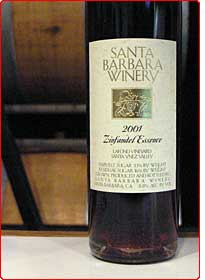 |
|
Wine Details
Price:
$24.00 per bottle
Description:
Early in his tenure at Santa Barbara Winery, Bruce had observed some Zinfandel bunches shriveling and drying out while staying free of rot. Mindful of the terrific forward fruit and the firm acid structure courtesy of the cool climate, Bruce made his first batch of Zinfandel Essence in the 1980's.
Because the Fall of 2001 was sunny and dry, Bruce waited until November 25th to pick the Zinfandel raisins that were then foot stomped to gently release juice and start the fermentation. After pressing, the juice was cold fermented in stainless steel to retain maximum fruit character.
|
|
Varietal Definition
Zinfandel:
Zinfandel is a variety of red grape planted in over 10 percent of California wine vineyards. DNA fingerprinting revealed that it is genetically equivalent to the Croatian grape Crljenak Kaštelanski, and also the Primitivo variety traditionally grown in the 'heel' of Italy. It is typically made into a robust red wine. Its taste depends on the ripeness of the grapes from which it is made. Red berry fruits like raspberry predominate in wines from cooler areas such as the Napa Valley, whereas blackberry, anise and pepper notes are more common in wines made in warmer areas such as Sonoma County. Many Zinfandels come from head pruned ‘Old Vines’. ‘Old Vine’ is generally understood to mean a vine that is more than 50 years old and that produces less than three tons per acre. ‘Head Pruning’ is an old European style of pruning that trains the vine into the shape of a goblet. It requires no wires or other complex trellis systems. Head pruning spreads the fruit uniformly along the vine and allows light penetration.In the USA a semi-sweet Rosé (blush-style) wine called ‘White Zinfandel’ has achieved widespread popularity. In fact, this popularity has so outstripped all other forms that many fans think there is actually a grape called “White Zinfandel” (there isn’t)!
|
Sauvignon Blanc:
Sauvignon Blanc is widely grown in California — at over 15,000 acres, it’s now the third most planted variety — and often assumes the moniker ‘Fume Blanc’. This popular synonym, credited to Napa’s Robert Mondavi, derives from the grape’s historic home of Pouilly in France’s Upper Loire Valley, where Sauvignon Blanc is the dominant varietal and goes locally by the name of ‘Blanc Fumé’. When treated with respect and afforded suitable growing conditions, Sauvignon Blanc is one of the wine world’s darlings. Steely, racy acidity, green, gooseberry fruit, asparagus and a grassy, herbaceous character characterize dry wines made from this grape.
|
|